

Cottonwood Lexile & Differentiation PD 12 2 20. Vaughn Gross Center for Reading and Language Arts. 10Keys Secondary Web. 10Keys Reading Web Revised. Florida Center for Reading Research. Part of the Florida Center for Reading Research’s mission is to disseminate information about research-based practices related to literacy instruction and assessment for children in Pre-K through 12th grade.
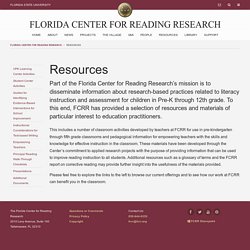
To this end, FCRR has provided a selection of resources and materials of particular interest to education practitioners. This includes a number of classroom activities developed by teachers at FCRR for use in pre-kindergarten through fifth grade classrooms and pedagogical information for empowering teachers with the skills and knowledge for effective instruction in the classroom. These materials have been developed through the Center’s commitment to applied research projects with the purpose of providing information that can be used to improve reading instruction to all students.
Additional resources such as a glossary of terms and the FCRR report on corrective reading may provide further insight into the usefulness of the materials provided. Ice Cream Scoop CVC Words - The Kindergarten Connection. This website uses cookies to improve your experience.

We'll assume you're ok with this, but you can opt-out if you wish.Accept Reject Read More Privacy & Cookies Policy. Text Features Frayer Glossary. How to Teach Expository Text Structure to Facilitate Reading Comprehension. Click the "References" link above to hide these references.
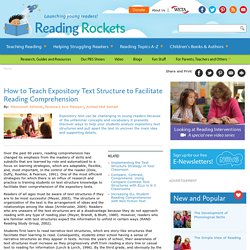
Aebersold, J.A., & Field, M.L. (1997). From reader to reading teacher: Issues and strategies for second language classrooms. New York: Cambridge University Press. Armbruster, B.B. (2004). Considerate texts. Carrell, P.L. (1985). Dole, J.A., Duffy, G.G., Roehler, L.R., & Pearson, P.D. (1991). The 8 Types of Thinking Maps Explained with Editable Templates. When it comes to teaching and learning, visuals play a major role in simplifying things.
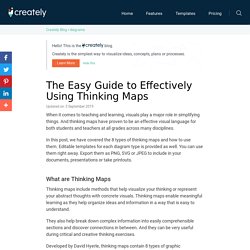
And thinking maps have proven to be an effective visual language for both students and teachers at all grades across many disciplines. In this post, we have covered the 8 types of thinking maps and how to use them. Editable templates for each diagram type is provided as well. You can use them right away. Export them as PNG, SVG or JPEG to include in your documents, presentations or take printouts. What are Thinking Maps Thinking maps include methods that help visualize your thinking or represent your abstract thoughts with concrete visuals. They also help break down complex information into easily comprehensible sections and discover connections in between.
Developed by David Hyerle, thinking maps contain 8 types of graphic organizers. There are several benefits to using thinking maps in education Types of Thinking Maps with Editable Thinking Map Templates. High Five. Classroom Strategies. Reciprocal Teaching. Question-Answer Relationships. Question-Answer Relationships, or QAR, is a reading comprehension strategy developed to encourage students to be active, strategic readers of texts.
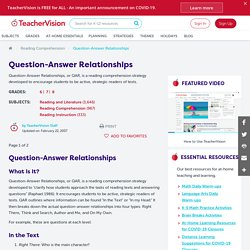
What Is It? Question-Answer Relationships, or QAR, is a reading comprehension strategy developed to "clarify how students approach the tasks of reading texts and answering questions" (Raphael 1986). It encourages students to be active, strategic readers of texts. QAR outlines where information can be found "In the Text" or "In my Head. " It then breaks down the actual question-answer relationships into four types: Right There, Think and Search, Author and Me, and On My Own. For example, these are questions at each level: In the Text Right There: Who is the main character? In My Head Author and Me: Would you have made the same choice the character made? Why Is It Important? Students often follow an extremely literal or "in their head" approach when answering questions about what they have read. How Can You Make It Happen? Seven Strategies to Teach Students Text Comprehension.
1.

Monitoring comprehension Students who are good at monitoring their comprehension know when they understand what they read and when they do not. They have strategies to "fix" problems in their understanding as the problems arise. Research shows that instruction, even in the early grades, can help students become better at monitoring their comprehension. Storyline Online. Launching Young Readers. Accelerated Reader Bookfinder US - Welcome. Early Literacy. Multi-Tiered Systems of Behavioral and Academic Support A Multi-Tiered System of Supports (MTSS) is a framework designed to respond to the needs of all students within a system which integrates, but is not limited to, tiered behavior (e.g.
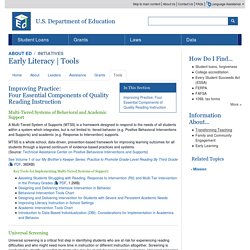
Positive Behavioral Interventions and Supports) and academic (e.g. Response to Intervention) supports. MTSS is a whole-school, data-driven, prevention-based framework for improving learning outcomes for all students through a layered continuum of evidence-based practices and systems. (Source: Technical Assistance Center on Positive Behavioral Interventions and Supports) See Volume 1 of our My Brother’s Keeper Series: Practice to Promote Grade-Level Reading By Third Grade ( PDF, 360KB) Key Tools for Implementing Multi-Tiered Systems of Support: Universal Screening See Volume 2 of our My Brother’s Keeper Series: Practice to Promote Grade-Level Reading By Third Grade ( PDF, 401KB) Key Tools for Implementing Universal Screening: Progress Monitoring Top. Graphic Organizer Maker. Instructional Content Platform. ReadWorks.
Teaching Resources & Lesson Plans. Starfall: Learn to Read with Phonics, Learn Mathematics. Moodle. Book List.